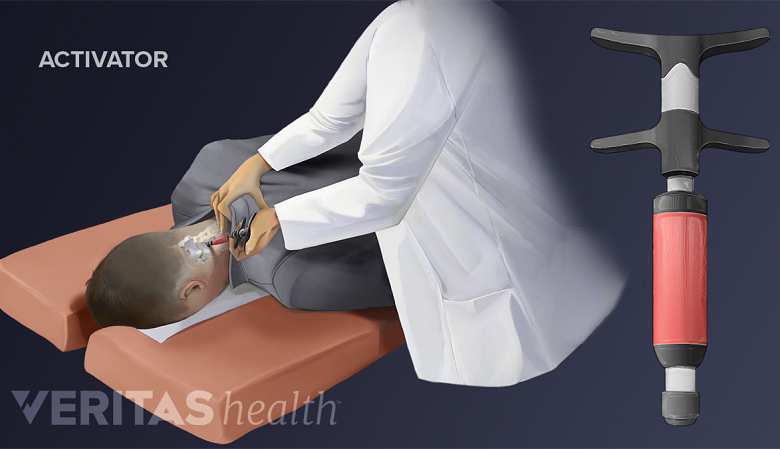There are many different chiropractic techniques. Some doctors of chiropractic perform joint manipulation with their hands only, while others use various instruments. Additionally, some chiropractors treat using quick but firm manipulation while others have a lighter touch.
In This Article:
- How To Select The Best Chiropractor
- Questions to Ask About Chiropractic Techniques
- Chiropractic Treatment Program Guidelines
- Chiropractic Health Care and X-Rays
- How to Choose a Chiropractic Clinic
- Did Chiropractic Work? Re-evaluating Your Treatment Plan
Common hands-on techniques include the following:
Spinal manipulation
This treatment is most typically associated with chiropractic care. A chiropractor uses their hands to perform a quick high-velocity, low-amplitude adjustment of a spinal joint. This adjustment involves enough force to release the joint out of its restricted motion (but within the joint’s anatomical limits) in an effort to improve mobility and reduce pain. This quick manipulation is technically referred to as a high velocity, low amplitude” thrust (HVLA) and typically causes a popping or cracking sound, called cavitation. Some people enjoy the HVLA form of manipulation and find it therapeutic, whereas other people may find this sound disturbing. Although the procedure itself is not painful, in the presence of inflammation where simply touching the area causes tenderness, some brief discomfort is common.
See Understanding Spinal Manipulation
Spinal mobilization
The activator device enhances spinal mobilization with quick, low-force impulses to specific joints.
This technique involves slow and steady movement of the spinal joints through their range of motion—either by using the hands or a device, or stimulation of the spinal joints using an instrument. While this treatment shares the same goals as spinal manipulation, some people may prefer spinal mobilization because it is gentler and does not involve audible popping or cracking sounds. Though gentler in approach, in some cases mobilization may result in a slower recovery and hence, a longer course of care than manipulation.
While chiropractors commonly implement these treatments, other appropriately trained professionals, such as physical therapists and osteopathic physicians may also use these techniques.
People have reported benefits from both spinal manipulation and spinal mobilization for spine-related pain, such as in the neck and back. 1 Gross A, Langevin P, Burnie SJ, et al. Manipulation and mobilisation for neck pain contrasted against an inactive control or another active treatment. Cochrane Database Syst Rev. 2015 Sep 23;(9):CD004249. doi: 10.1002/14651858.CD004249.pub4. , 2 Cleland JA, Glynn P, Whitman JM, Eberhart SL, MacDonald C, Childs JD. Short-term effects of thrust versus nonthrust mobilization/manipulation directed at the thoracic spine in patient with neck pain: a randomized trial. Phys Ther. 2007; 87(4):431-40. , 3 Coulter ID, Crawford C, Herman PM. Manipulation and mobilization for treating chronic low back pain: a systematic review and meta-analysis. Spine J. 2018; 18(5):866-879. Some chiropractors may recommend a combination of both spinal manipulation and mobilization.
Sample Questions About Techniques
While the following questions about chiropractic care do not have a right or wrong answer, having an understanding of the chiropractor’s techniques can help the patient better assess whether there is a good patient-chiropractor fit.
- Which chiropractic techniques does the chiropractor use and why? Most chiropractors are experienced in a range of techniques and will pick the ones best suited to the patient and their condition.
- Does the chiropractor use his or her hands, an instrument for the spinal manipulation, or both?
- Does the chiropractor employ a deeper, joint-popping adjustment or a low-force adjustment?
- Is the chiropractor experienced in treating problems similar to the patient's diagnosis?
- How much training and experience does the chiropractor have in the specific technique they are recommending?
After asking these questions, the individual may find that further research about specific chiropractic techniques is necessary.
Potential Red Flags about Chiropractic Practices
There are a few chiropractic practices that most chiropractors agree are questionable. Examples of questionable techniques include:
- The chiropractor claims to be the only one with a new technique that no other chiropractor utilizes.
- The chiropractor claims to be able to cure various medical conditions, such as asthma, heartburn, infections or some other chronic systemic condition.
- The chiropractor recommends the same type of treatment for virtually every patient, regardless of the patient's condition.
- The chiropractor continually recommends ongoing care with no goals, progress assessment, or end point.
If a patient experiences any of the above, it is reasonable to consider changing to another chiropractor or seeking a second opinion.
- 1 Gross A, Langevin P, Burnie SJ, et al. Manipulation and mobilisation for neck pain contrasted against an inactive control or another active treatment. Cochrane Database Syst Rev. 2015 Sep 23;(9):CD004249. doi: 10.1002/14651858.CD004249.pub4.
- 2 Cleland JA, Glynn P, Whitman JM, Eberhart SL, MacDonald C, Childs JD. Short-term effects of thrust versus nonthrust mobilization/manipulation directed at the thoracic spine in patient with neck pain: a randomized trial. Phys Ther. 2007; 87(4):431-40.
- 3 Coulter ID, Crawford C, Herman PM. Manipulation and mobilization for treating chronic low back pain: a systematic review and meta-analysis. Spine J. 2018; 18(5):866-879.










